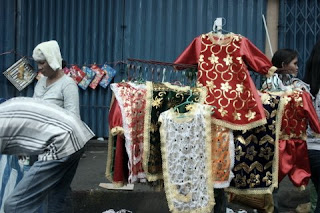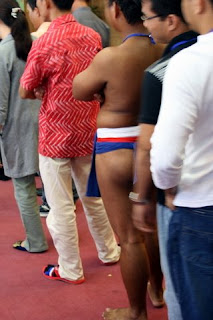On a cold, damp day in San Francisco, I was sitting in a bus, hardcore fiending for some Philippine cacao. Thick, dark, not instant stuff, not scrimping on the bean. It was pretty understandable that I frantically jumped up and yanked the stop cord as I saw a sign outside a cafe that said "
Champurrado! It's back!".
I had previously read that Mexicans made their
champurrado with corn, instead of rice. I was a bit disheartened, therefore, to receive a cup filled with what is basically hot chocolate with
masa harina (corn flour) and cinnamon mixed in. Or, from a corn-centric view, it is an
atole or corn-flour beverage with chocolate mixed in.
 Egads.
Egads.Of course, I grew up with Filipino
champorado-- whole pieces of sticky rice, floating (suspended) in a goop of thick, dark, chocolate. More like, the best porridge in the world. I was expecting whole corn bits for texture. This is not to say that it wasn't good-- frothy and at least more dense than most Western cacao drinks-- but the name can mislead poor homesick Filipinos.
 Street champorado.
Street champorado.Yesterday, I was walking the streets of Manila and came across a man pushing a cart with large vats of
champorado and
pansit. Many people congregated. I was interested in the chocolate stuff, as I always am!
 Most folks opt for evaporated milk on.
Most folks opt for evaporated milk on. Drowning in milk for this fellow.
Drowning in milk for this fellow.Curiously enough, the co-existence of
champurrado and
champorado brings historical interactions alive. While
champurrado had no doubt previously existed as
atole de chocolate, the Philippines only obtained cacao during the galleon trade. Our own version may have been a Spanish-time invention, but who gave it the name?
Apparently,
champurrar, vernacular Latin American for "mixing drinks", came from the Malay word
tchampur or
campur, meaning the same thing, or simply, "to add". Consider this a word that migrated into the Americas from Southeast Asia, and has gone as far as French Algeria (
champoraux, a coffee and alcohol mixture).
This puzzle of great variations, but same names (and an additional factor of possible renaming from an
atole to something specific), makes me think about galleon snippets. Boholano slaves in Acapulco and the current abundance of chocolate in Bohol. Our shared tool, the chocolate frother, there called
molinillo, here,
batirol,
batidor, or
chocolatera. And so on, and so forth.
What a species advantage it is-- to be delicious! The cacao needed only to hit a taste bud for humans to carry it across oceans and make it a part of their lives and desires.


















































